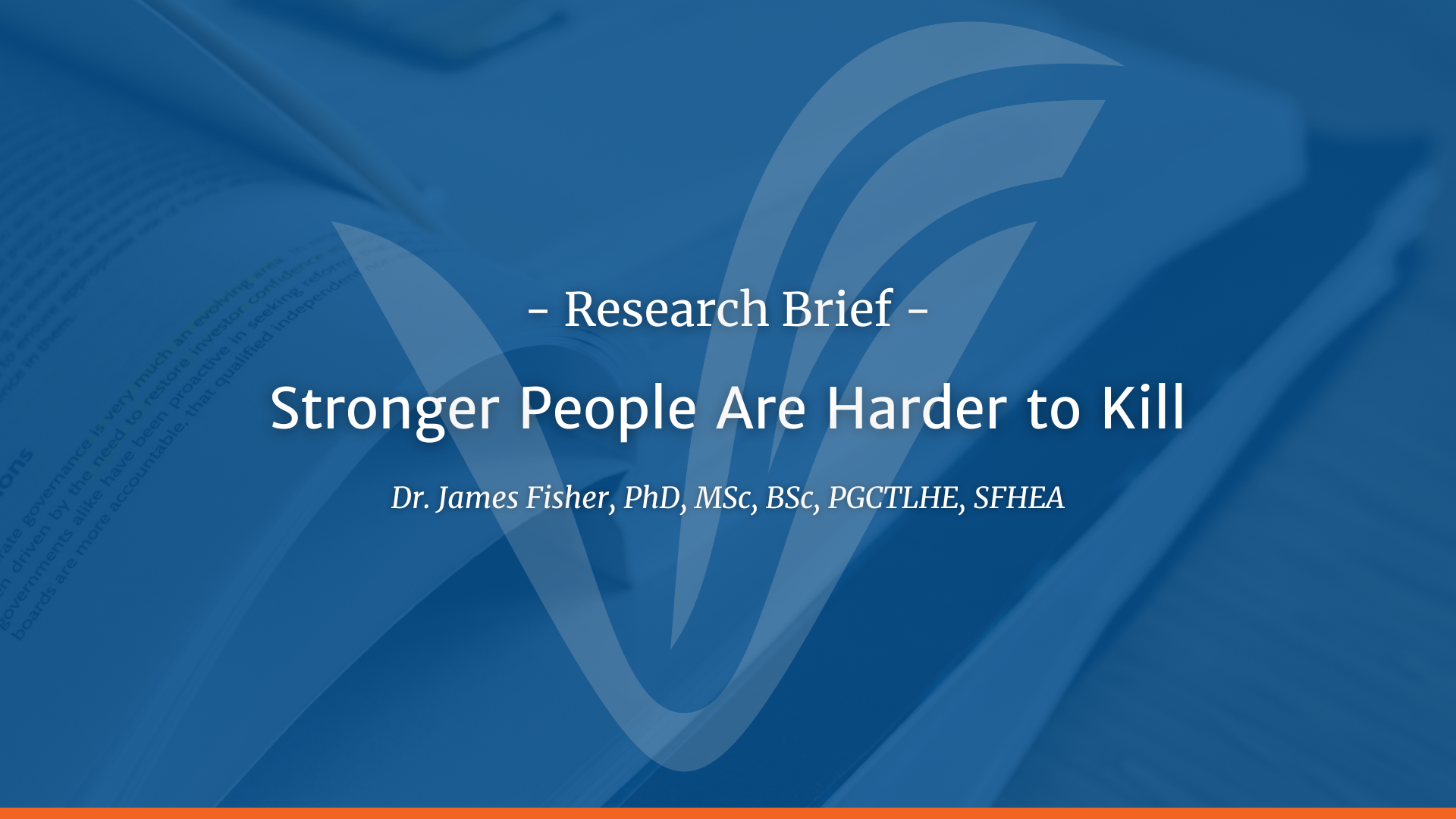Stronger People are Harder to Kill – The Necessity of Strength Training as We Age
An unquestionable body of research supports significant increases in strength, muscular health, and overall health as a result of strength training, most notably with older adults. While functional (i.e., “mechanical” or movement-oriented) strength changes are meaningful to quality of life, adaptations represent only one aspect of the physiologic health benefits that are derived from skeletal muscle. The muscular system is now widely regarded by physiologists as the largest and most important system of the human body due to its influence on most of the other systems of the body, chiefly the circulatory system, endocrine system, immune system, nervous system, skeletal system, and respiratory system. The central question that has been asked and answered by scientists who specialize in muscle physiology as it relates to population health is:
What can be done to maintain muscle health throughout the lifespan, especially as people age?
As it turns out, strength training, when performed correctly, is the ideal stimulus for a number of critical adaptations, including improvements in brain, bone, metabolic, and cardiovascular health. Furthermore, muscular strength, muscle mass, and muscle quality (measured as strength per unit of mass) strongly correlate with improved quality of life, chronic disease prevention, and reductions in all-cause mortality. Simply put, stronger people are harder to kill.
Numerous publications, as summarized below, have clearly and unequivocally demonstrated that strength training can literally reverse aging. Meaning that the human body functions better at the cellular, neurological, physiological, and whole organism levels. Yes, uncomplicated and time-efficient strength training can allow humans to function younger than our chronological age!
This research brief provides a short synopsis of noteworthy academic publications recognizing the importance of muscular strength for quality of life, bone-mineral density, cardiovascular health, all-cause mortality, and muscle mass increases, and finally, the mechanisms by which our muscles promote these health-related adaptations.
Strength and Quality of Life
Rantanen, et al. Midlife hand grip strength as a predictor of old age disability. Journal of the American Medical Association. (1999). Vol. 281:558-60.
Poor muscle strength is often associated with functional limitations and disability. Handgrip strength is a strong correlate of upper- and whole-body muscle strength. This research paper presents reports data for 6,089 males aged 45-68 years who were assessed for grip strength and, 25-years later, completed the disability assessment. After adjustment for potential confounders, slower walking speed and self-care disability were more than 2 times greater in the weakest third compared to the strongest third of patients. The authors concluded: ”… handgrip strength was highly predictive of functional limitations and disability 25 years later. Good muscle strength in midlife may protect people from old age disability…”
Bone – Mineral Density
Huovine, et al. Bone mineral density is increased after a 16-week resistance training intervention in elderly women with decreased muscle strength. European Journal of Endocrinology. (2016). Vol. 175:571-582.
Low bone mineral density is a risk factor for osteoporosis and associated fracture. In this study 37 elderly women (mean = 71.9 years) performed strength training 3x/ week. Following 16 weeks of training, participants had increased total hip bone mineral density by ~6%. The strength training intervention included simple machine-based exercises including leg press, chest press, seated row, abdominal crunches, back extensions, seated leg curls, and hip abductions for 8-15 repetitions. The authors reported: “Our findings suggest an important role of continuous supervised resistance training for the prevention of osteoporotic fractures in elderly women.”
Cardiovascular Health
Liu, et al. Associations of resistance exercise with cardiovascular disease morbidity and mortality. Medicine and Science in Sports and Exercise. (2019). Vol. 51:499-508.
Cardiovascular disease, such as stroke or heart attack, is the leading cause of death in most developed countries. This article presented data from 1987-2006 for 12,591 participants (Average age of 47 years), showing that strength training performed 1-3x/week equated to 40%–70% decrease in risk of cardiovascular disease events; thus, disproving the longstanding myth that cardiovascular health benefits can only be achieved with aerobic (walking, biking, jogging, etc.) exercise. This relationship was independent of whether participants performed aerobic exercise. Furthermore, there was no greater risk reduction achieved by strength training more frequently. The authors concluded: “Strength training even one time per week, independent of AE, is associated with reduced risks of cardiovascular disease and all-cause mortality”.
Strength and all-cause mortality
Ruiz, et al. Association between muscular strength and mortality in men: prospective cohort study. British Medical Journal. (2008). Vol. 337:a439.
This prospective study considered maximal strength for chest press and leg press for 8,762 males aged 20-80 years. Participants were categorized into low, medium, and high (“upper,” “mid,” and “lower”) strength groups, and were tracked for nearly 19 years. At follow-up 18.9 years later, the greatest number of deaths had occurred in the weakest third of the population – the lowest strength group – even after adjustments were made for age, physical activity, smoking, alcohol intake, body mass index, baseline medical conditions and family history of cardiovascular disease. The authors stated: “[Low] Muscular strength is inversely and independently associated with death from all causes, even after adjusting for cardiorespiratory fitness and other potential confounders.”
Muscle Mass Index
Srikanthan & Karlamangla. Muscle mass index as a predictor of longevity in older adults. American Journal of Medicine. (2014). Vol. 127:547-53.
Obesity (defined by body mass index) often results in guidance to “lose weight.” Where the weight is coming from should be a chief concern for anyone administering a weight loss program due to the high potential to lose metabolically active tissue (muscle mass) when strength training is not included.
Analysing data for 3,659 participants from the National Health and Nutrition Examination Survey, these authors compared body mass index (BMI) to muscle mass index, finding the highest muscle mass index was associated with higher body mass index. However, the authors also reported that death by all causes was lowest in the group with the highest quartile of muscular strength – which was also the highest quartile for body mass index. These authors clarified: “This study demonstrates the survival predication ability of relative muscle mass and highlights the need to look beyond total body mass index in assessing the health of older adults.”
Overweight but Fit Paradigm
Buckner, et al. Lower extremity strength, systemic inflammation, and all-cause mortality: Application to the so called “fat but fit” paradigm using crosssectional and longitudinal designs. Physiology and Behavior. (2015). Vol. 149:199-202.
A growing area of discussion is that a person can be overweight but still have considerable health benefits by performing exercise despite any excess adipose tissue (e.g., “fat but fit”). These authors reviewed data from the National Health and Nutrition Examination Survey for 2,740 adults >50 years. C-reactive protein (CRP; from a blood sample which is a recognised marker of cellular health) was assessed in combination with isokinetic knee extensor strength. Participants were then classified based on body mass index and strength as follows: normal weight and unfit, overweight and unfit, obese and unfit, normal weight and fit, overweight and fit, and obese and fit. The data suggests that fitness negates the implications of being overweight. Interestingly, when compared to normal weight unfit adults, overweight and fit adults had a lower risk of all-cause mortality. In essence, thin doesn’t necessarily equate to op(mal health and longevity, as many people believe. The authors summarized: “… increased lower body strength may reduce premature all-cause mortality and attenuate systemic inflammation among overweight adults”.
Myokines
Zunner et al. Myokines and Resistance Training: A Narrative Review. International Journal of Molecular Sciences. (2022) Vol. 23:3501.
For decades it was perceived that a primary health benefit of muscular activity was its calorific and thermogenic effect. Strength training amounted to larger muscles and greater strength and with it a greater daily calorie expenditure. However, in the past 30 years the paradigm has shifted – we now recognize skeletal muscle as an endocrine organ producing and releasing “myokines” which work in a hormone-like fashion to positively impact our health. Myokines are anti-inflammatory, improve immunological processes, and combat metabolic diseases, cancer, and neurodegenerative diseases (Alzheimer’s, Dementia, etc.). High effort strength training is the muscular activity primarily responsible for a significant number of myokines. Studies with the highest myokine output involved a full-body resistance workout including large muscle groups. These authors reported: “…even a single session of exercise produces meaningful myokine release, this means, for practical implementation, every session of resistance training counts.”





